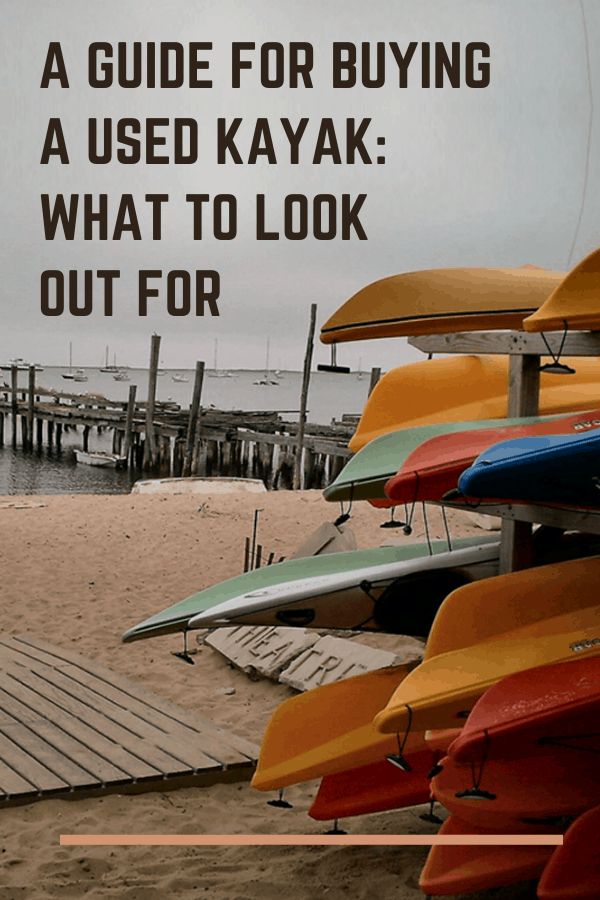Owning your own kayak is the goal of most kayakers because it gives you the freedom to get out on the water whenever the need strikes you. If you prefer a specific type of kayaking that requires a certain style of kayak, like whitewater kayaking or kayak touring, then buying your own might be the only way to find the boat you are looking for.
The downside to buying your own kayak is it can get pricey. Kayaks come in a whole range of models and prices, with a brand new one costing anywhere from $500 to $1,500. If you are just getting started in your kayaking adventure then that cost might be a little too sharp for comfort.
Buying a used kayak is a great alternative. It offers you the chance to own your boat without spending a vast amount. Buying the right second-hand kayak requires an understanding of what to look for and where to look for it. To help out, we’ve put together this guide for buying a used kayak.
Where to Buy a Used Kayak
Online
The idea of buying a kayak online may understandably make you a little wary. We’ve all had a least one negative online buying experience and it’s not something most people are keen to relive with something as expensive as a kayak.
The good news is that the size and bulk of a kayak make it almost impossible to ship, so you’ll either have to collect it or have to bring to you. This gives you the opportunity to inspect the kayak before you hand over any money.
There are a growing number of second-hand websites that the kayaking community uses to sell used kayaks. Some of the more popular ones are as follows:
In Person
Sourcing a used kayak from a local store might be a little more difficult than finding online, but it’s not impossible. Check around local sports and fishing stores, or visit flea markets or kayaking events.
The kayaking community is fairly close-knit, so even if the places you visit don’t have the right used kayak for sale they may know someone in your local area who does. You could also try posting on kayaking message boards, advertising that you are looking to buy a used kayak. This also lets you specify exactly what kind of kayak you are looking for to help filter your responses.
Inspecting a Used Kayak
The most important part of buying a used kayak is inspecting it for any damage or faults. Wear and tear is to be expected on any second-hand sporting equipment, but you’ll need to make sure there is no significant damage to the hull or fittings.
Knowing what to look for when checking over a second-hand kayak can be a little difficult, especially if you are just starting out. Below we’ve put together a list of things to consider so you can get a better understanding of what condition the kayak you are inspecting is in, helping you make your decision on whether to buy it or not.
How Was It Stored?
How a kayak has been stored can have a significant effect on its overall condition. Some kayak hulls, particularly those made of plastic, are vulnerable to warping if improperly stored.
Ideally, a kayak should be stored out of the elements and suspended off the ground. This prevents the sun and the kayaks own weight from warping it.
If the kayak you are thinking of buying has clearly been stored outside or simply left to sit on the ground, you will need to examine its lines for warpage. If the shape of the kayak’s hull has been significantly bent or twisted, then its performance in the water will be negatively impacted and you should probably look for a different kayak.
If the kayak has been stored under a tarpaulin, it is best to check for signs of mold or mildew growth. Tarps catch and hold moisture, making the dark inner spaces of a kayak an ideal place to grow a variety of flora. While most mildew can just be washed off with hot water and bleach, some types of mold secrete chemicals that can damage a kayak’s hull.
The Fittings
While improper storage can potentially damage the hull of a kayak, the fittings are where you are mostly like to find damage from usage. While most fittings can be replaced, damaged fittings will affect the value of used kayak. Here are a few things to look out for:
- Hatch Covers: Hatch covers seal up the storage spaces in the kayak hull and are vital to keeping your gear safely stowed and preventing water from getting in. Hatch covers can rot, be broken, be missing, or the rubber seals that keep them watertight can perish.
- Foot Pegs: Foot braces or pegs keep the kayaker firmly in their seat and allow them to use their body to more efficiently turn and paddle. Broken or missing footpegs can easily be replaced but will affect the value of kayak.
- Seats and Thigh/Knee Pads: Most kayak seats are removable and made of hard wearing materials such as polyurethane and nylon. Thigh and knee pads are normally located inside a sit-in kayak hull and make the cockpit fitting secure and comfortable. When buying a used kayak it’s best to find out if the model of kayak you are looking at came with these items originally, and check to see if they are still there and in good condition.
- Storage Cords: External storage on a kayak is normally taken care of by bungee or shock cording. These cords are vulnerable to UV damage, salt erosion, and to the elements, if the kayak is stored outdoors. Check these cords for frayed edges or brittleness.
- Bolts: Most kayak fittings are attached to the hull with stainless steel bolts or screws. Always check these attachment points for corrosion. If there is significant corrosion then do not try to use main force to unseal them, as this can result in the bolt ripping away from the hull. Instead, use high penetration oil to free up the bolt before attempting to turn it. In some cases, the corrosion might be so severe that the bolt will need to be replaced and reattached to the hull.
- Rudder or Skeg: Rudder lines will need to be checked for erosion or degradation while the actual mechanism for the rudder should be checked to make sure it is functional. If you are planning on buying a used kayak with a rudder, it is always a good idea to find out if replacement parts for that particular model can still be purchased. A skeg, or static rudder, has no moving parts but it is worth checking the blade of the skeg for any potential collision or drag damage. Both skegs and rudders are sometimes retractable. If that is the case then you will need to check the lowering/raising cables for damage.
Plastic Hulls
Plastic-hulled kayaks, normally made from durable materials such as polyurethane, are inexpensive and impact resistant. Out of the all the kayak hulls they are the most vulnerable to warping due to poor storage conditions. When checking over a plastic kayak hull, look for any significant warping of its lines by flipping it over.
Small scrapes and gouges in a second-hand kayak are to be expected and can be repaired with a combination of heat and pressure, but be on the lookout for any deep dents or thin points due to drag damage.
Thermoform Hulls
Occupying a mid-point between plastic and composite hulls, thermoform kayaks retain some of the impact resistance of a plastic hull while being lighter and more rigid. When checking over a thermoform kayak, look for the same deep dents and warping you would look for in a plastic kayak.
In addition, the Acrylonitrile Butadiene Styrene (ABS) material that is commonly used to make thermoform hulls can become brittle if exposed to the elements. Look for cracks around the cockpit rim and edges of the deck that might indicate this.
Composite Hulls
Constructed from layers of materials such as fiberglass, aramid, and carbon, composite hulls are lighter and more rigid than plastic hulls, although they are more vulnerable to impact damage.
Because of their layered construction, damage to the hull of a composite kayak can lead to water seeping into those layers, causing the hull to delaminate.
When checking over the hull of a composite kayak, look for any deep gouges that may have penetrated the gel coat that is the last and most resistant layer of the hull. Bubbling, warping, and discoloration around damage to the hull may indicate delamination.
If you find evidence of this it is best to look for a differently used kayak as delamination can be both progressive and difficult to fully repair. Â Â
Going for a Test Paddle
If at all possible, it is best to take a used kayak you are thinking of buying for a test paddle, just as you would test drive a car. Most used kayak sellers will be fine with you asking to do this.
When test paddling your kayak there are a number of things you should be checking for:
- The Fit: When buying any kayak, making sure you have the right fit for your body shape is essential. The cockpit should feel secure but not cramped, and you should be able to stretch out your legs without any uncomfortable obstructions. Leg and back pain, or any of your limbs falling asleep while paddling, is a good indication that this particular kayak is not a good fit for you.
- The Performance: Just as important as the fit is the kayak’s performance. A kayak is an investment that can last for years, so consider if the kayak you have picked is stable enough for your needs. Does it move at the speed you expected? Is it maneuverable enough to suit your paddling style?
- The Hull: Pay attention to the kayak’s tracking while you are out on the water. Significant tracking issues could indicate warping in the kayak’s hull. Also, keep an eye on the inside of your kayak to see if any water is leaking in.
- The Fittings: Testing the kayak is an excellent way to check the function of any mechanical fixtures, such as a rudder or retractable skeg. Make sure the motion of raising or lowering the rudder/skeg is smooth and the rudder doesn’t jerk or stick as you use it.
How Much Should You Pay for a Used Kayak?
Unfortunately, there isn’t an easy answer to these questions. Used kayaks can range from 50 percent to 75 percent of their recommended retail price, but much of what you can expect to pay for them is based on the condition of the individual kayak. Having an idea of the what the kayak costs when it was new is a good guideline to how much you should be paying for it second-hand.
The guided price that you have in mind should then be altered by the actual state of the kayak and its constituent parts. Damage to the hull and its features will need to be repaired or replaced.
This can take up your time and add, sometimes significantly, to the costs of the kayak. If there is damage to the kayak, especially if that damage will require parts to be replaced, you should negotiate the price with the seller or politely decline the sale and look for a more suitable kayak.
This guide should help you figure out just how much you should pay for a used kayak. Keep these tips in mind and you’ll find your forever kayak in no time!
More From KayakHelp:
- Best Sea Kayaks
- Best River Kayaks
- Best Surfing Kayaks
- Best Sit On Top Kayaks
- Best Kayaks For Beginners


